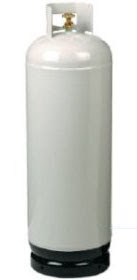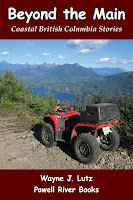 |
| Our original propane stove. |
Power in a remote, off-the-grid cabin takes many forms. When we purchased our float cabin, it came with
propane. This was our first time to use propane. Of course, in the city, we were used to natural gas for heating and appliances, but propane in its own tank was new and a little scary. In the beginning, we only used it for the burners on the stove. Now that we are more comfortable with propane, we use the propane powered refrigerator and lights.
Propane is also called LPG (liquefied petroleum gas). Many people use it in small canisters for camp stoves and barbeques.
 |
| Checking the tanks in the shed. |
Rural houses are often designed to use propane from large outdoor tanks, much like city homes use natural gas. Propane is transported and stored in tanks as a very cold liquid. Liquid propane is turned into a gas inside the tank which is transported through thin pipes to appliances.
Care needs to be taken when using propane as a power source. The vapors are heavier than air, so they can build up in low spots and be ignited by a flame or spark. If care is taken to check all pipes and fittings, and to locate storage tanks outdoors, there is little danger. Also, to make it easier to detect a propane leak, a chemical has been added to give it a distinctive smell.
 |
| Propane tank. |
We have three 40 pound propane tanks that are housed in a lean-to on the side of the cabin. One tank usually lasts us about four weeks in winter when we are using it for lights, cooking and the refrigerator. In the summer, when we don’t need the lights, it lasts about a bit longer. Having spare tanks makes it easy to swap them when we run low. An empty tank is fairly light, but a full one is pretty heavy to haul down the dock and into the boat. A dolly (hand truck) makes the haul a little easier.
One thing we had a hard time understanding was, “How can a gas flame create cooling in a refrigerator?” The
Gas-Fridge.com website says:
 |
| Our original propane fridge. |
"The basic principle is to create cooling through evaporation. An ammonia mixture sealed inside the cooling unit is heated by a gas burner, which causes it to circulate before it evaporates and creates a cooling effect. The continuous heating, evaporating, and condensing is a never-ending cycle that keeps your food and beverages cold." Now we can have ice and make ice cream at our cabin for those warm summer days. Can’t wait!! -- Margy






















































